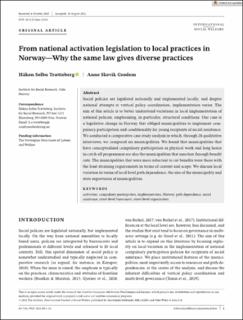| dc.description.abstract | Social policies are legislated nationally and implemented locally, and despite national attempts at vertical policy coordination, implementation varies. The aim of this article is to better understand variations in local implementation of national policies, emphasising, in particular, structural conditions. Our case is a legislative change in Norway that obliged municipalities to implement compulsory participation and conditionality for young recipients of social assistance. We conducted a comparative case study analysis in which, through 28 qualitative interviews, we compared six municipalities. We found that municipalities that have conceptualised compulsory participation as physical work and long hours in catch-all programmes are also the municipalities that sanction through benefit cuts. The municipalities that were more reluctant to cut benefits were those with the least straining requirements in terms of content and scope. We discuss local variation in terms of local-level path dependence, the size of the municipality and state supervision of municipalities. | |
